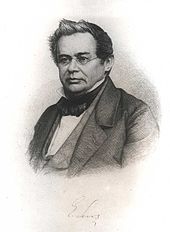Emil Lenz
Heinrich Friedrich Emil Lenz ( Russian Эмилий Христианович Ленц ; born March 12, jul. / 24. March 1804 greg. In Dorpat (now Tartu, Estonia ); † 10. February 1865 in Rome ) was a Baltic German physicist who as a the first to recognize the relationships between magnetic fields and electric fields . So he laid the basis for the eddy current brake with Lenz's rule .
Life
family
Emil Lenz was born in 1804 as the son of a secretary to the mayor in Dorpat (now Tartu in Estonia), at that time still a predominantly German-speaking town. He studied at the University of Dorpat . Two years later, on July 18, 1830, he married Anna Helmersen , with whom he had 6 children. In the meantime, Lenz worked as a physics teacher at the German-speaking Saint Petersburg Petri School . His first son Robert (1833-1903) later became, like him, a professor of physics in St. Petersburg. Two of his children died in 1859. When he fell ill in the spring of 1864, he was granted a vacation in Rome, where he died of a stroke on February 10 of the following year .
Career
Before graduating, he gained important scientific knowledge as a companion of the Russian navigator Otto von Kotzebue on his third voyage around the world from 1823 to 1826, which mainly served to explore the Pacific . During this trip he was mainly active in the field of geophysics , including oceanographic studies of the temperature profile of air and water , as well as the salinity of water in different geographical latitudes . After his return, he earned his doctorate at the University of Heidelberg and then worked in the Russian capital St. Petersburg . As a result of his services to circumnavigate the world, he became adjunct of the Academy of Sciences in St. Petersburg in 1828 . Three years later he took over the post of director of the physics cabinet of the academy. Meanwhile, in 1830 and 1831, he taught mathematics at the Petri School and Michael Artillery School in Petersburg. Four years after Lenz was an associate member, he was elected a full member of the Russian Academy of Sciences in 1834. In the same year he also became professor of physics at the University of Saint Petersburg , where he was also rector from 1861 until his death in 1865. From 1853 he was a corresponding member of the Berlin Academy of Sciences . In 1864 he was elected a corresponding member of the Göttingen Academy of Sciences .
Scientific Achievements
Lenz's scientific achievements are primarily to be found in the field of electricity . He dealt with the electromagnetic induction discovered by Michael Faraday . As early as 1830 he discovered that an electric motor could also be used as a generator . Furthermore, during these investigations in 1833 he established Lenz's rule , which states that the direction of the induction currents is not random, but always counteracts the cause of their origin. Furthermore, in 1835 he discovered the temperature dependence of conductivity in metals as well as electrical resistances and a method for measuring magnetic fields. By applying the Peltier effect , he managed water to freeze to bring. In addition, together with James Prescott Joule, he determined quantitative characteristics of electricity heat (the Joule-Lenz law ).
Honor
In honor of Lenz, the symbol L was chosen for the electrical quantity inductance .
literature
- Peer Hempel: German-speaking physicists in old St. Petersburg: Georg Parrot, Emil Lenz and Moritz Jacobi in the context of science and politics , Oldenbourg Wissenschaftsverlag, Munich 1999, ISBN 3-486-56446-3 , (publications of the Federal Institute for East German Culture and History , Volume 14, dissertation at the University of Oldenburg 1998), pages 135-164
- K. Jäger, F. Heilbronner (Ed.): Lexikon der Elektrotechniker , VDE Verlag, 2nd edition from 2010, Berlin / Offenbach, ISBN 978-3-8007-2903-6 , p. 263
- Olga A. Lezhneva: Lenz, Heinrich Friedrich Emil . In: Charles Coulston Gillispie (Ed.): Dictionary of Scientific Biography . tape 8 : Jonathan Homer Lane - Pierre Joseph Macquer . Charles Scribner's Sons, New York 1973, p. 187-189 .
Web links
- Literature by and about Emil Lenz in the catalog of the German National Library
- Baltic Historical Commission (Ed.): Entry on Emil Lenz. In: BBLD - Baltic Biographical Lexicon digital
- Album academicum of the Imperial University of Dorpat , Dorpat 1889
- Entry in the student lexicon of physics , as seen on May 28, 2011
- Information about Lenz on Electrosuisse.ch (PDF; 30 kB), seen on May 28, 2011
Individual evidence
- ↑ Entry in the baptismal register of St. John's Church in Dorpat (Estonian: Tartu Jaani kirik).
- ↑ Holger Krahnke: The members of the Academy of Sciences in Göttingen 1751-2001 (= Treatises of the Academy of Sciences in Göttingen, Philological-Historical Class. Volume 3, Vol. 246 = Treatises of the Academy of Sciences in Göttingen, Mathematical-Physical Class. Episode 3, vol. 50). Vandenhoeck & Ruprecht, Göttingen 2001, ISBN 3-525-82516-1 , p. 149.
- ↑ Lenz on Personenlexikon.net , viewed on May 28, 2011.
- ↑ Tino Hempel: Physical symbols ... and their origins tinohempel.de, Ribnitz-Damgarten 1997–2008, accessed February 20, 2020. - Hempel refers to Johannes C. Pahl.
| personal data | |
|---|---|
| SURNAME | Lenz, Emil |
| ALTERNATIVE NAMES | Lenz, Heinrich Friedrich Emil (full name); Ленц, Эмилий Христианович (Russian spelling) |
| BRIEF DESCRIPTION | German-Baltic physicist |
| DATE OF BIRTH | March 24, 1804 |
| PLACE OF BIRTH | Dorpat |
| DATE OF DEATH | February 10, 1865 |
| Place of death | Rome |
